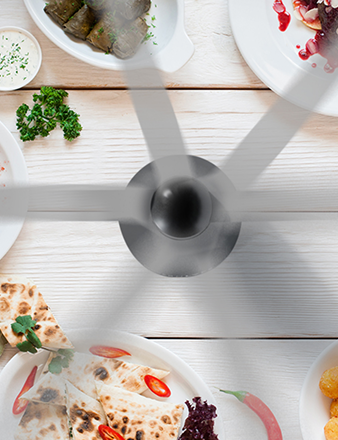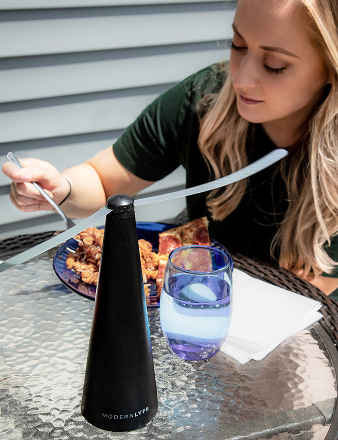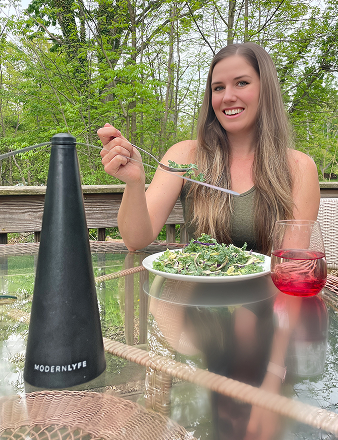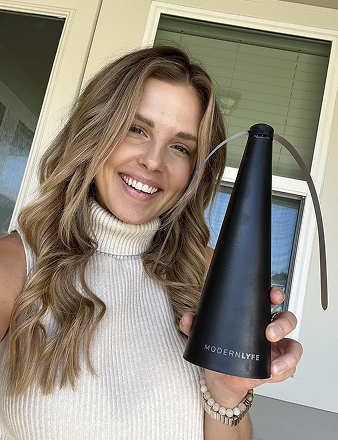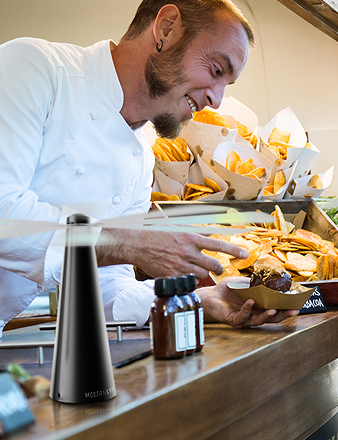Food safety isn't complicated. It boils down to four simple actions: Clean, Separate, Cook, and Chill. This isn't just a catchy phrase—it's the proven framework for handling, cooking, and storing food safely. Think of it as your best defense against the harmful bacteria and viruses you can’t see, smell, or taste.
Understanding the Real Risks in Your Kitchen
Nobody plans on getting food poisoning, but it's a common problem. It’s easy to get too comfortable in your own kitchen, assuming your habits are good enough. The reality is that pathogens like Salmonella, E. coli, and Listeria spread through small mistakes you might not even notice.
Here’s a common kitchen scenario: you slice raw chicken on a cutting board, toss it in the pan, then use that same board to chop lettuce for a salad. In that one move, you've likely transferred bacteria from raw meat directly to produce that won't be cooked. That’s cross-contamination, and it’s a leading cause of foodborne illness at home and in professional kitchens.
Contamination doesn't stop there. Bacteria can travel from your hands to the fridge handle, from a dirty knife to a clean one, or from a splash of raw chicken juice on the counter. The first step to preventing foodborne illness is understanding how these invisible threats move around your workspace.
This infographic gives you a powerful visual of how quickly germs can spread across a kitchen counter from just one contaminated source.

As you can see, without meticulous separation and cleaning, one contaminated item can compromise your entire prep area.
The Global Impact of Unsafe Food
While a foodborne illness might just mean a rough couple of days for most, the worldwide consequences are staggering. This is a massive public health issue that extends far beyond a single kitchen.
Unsafe food causes an estimated 600 million cases of foodborne illness across the globe each year, leading to about 420,000 deaths. Children under five are the most vulnerable, accounting for nearly 30% of these fatalities. These numbers underscore how vital strict hygiene practices are, from farm to table. You can read more about the global burden of foodborne diseases to see the full picture.
The core principles—Clean, Separate, Cook, and Chill—aren’t just guidelines. They are the essential pillars that keep these statistics from getting worse. Mastering them is non-negotiable for protecting your family, your customers, and yourself.
Building a Foundation of Prevention
Every food safety technique is built on these four simple concepts.
- Clean: More than a quick rinse. Wash hands thoroughly, sanitize surfaces, and clean produce properly.
- Separate: Keep raw and ready-to-eat foods apart. Always use different cutting boards, plates, and utensils for them.
- Cook: Heat is your best tool for killing germs. A food thermometer is the only way to be sure food has reached a safe internal temperature.
- Chill: Cold temperatures slow the growth of dangerous bacteria. Get groceries and leftovers into the fridge quickly.
Once you understand why these steps are so critical, they stop feeling like chores and become second nature—a proactive shield against illness.
Mastering the Four Pillars of Food Safety
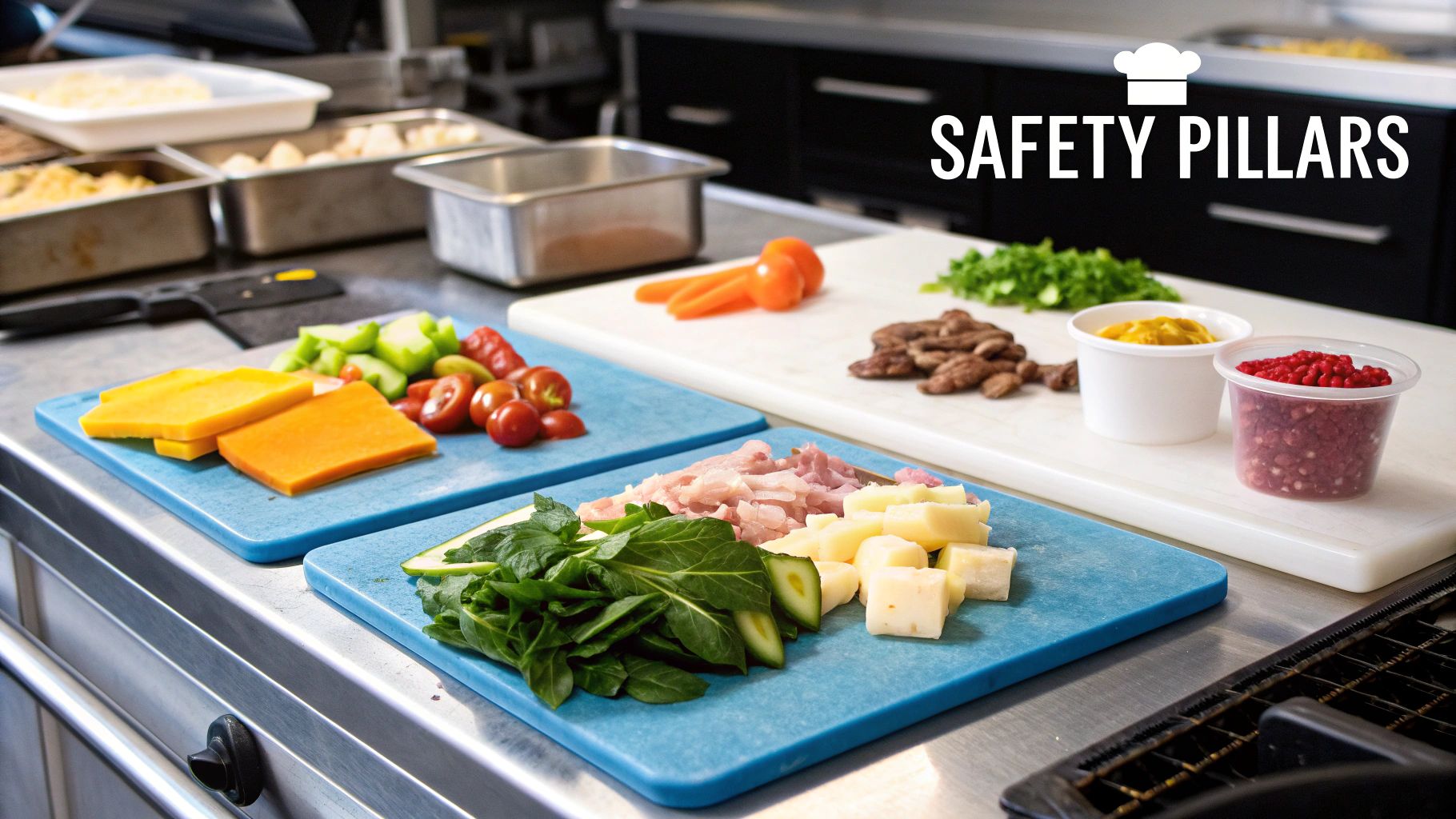
To prevent foodborne illness, you have to move beyond just knowing the rules and start living them. The four pillars—Clean, Separate, Cook, and Chill—are the non-negotiable framework for every meal. This isn't about following a checklist; it's about building strong habits that become automatic.
These principles are the building blocks for even the most advanced food safety systems. For anyone in food service, mastering these is the first step. You can see how these concepts scale up by reading our guide that answers the question, what is HACCP food safety?
The First Pillar: Clean
Cleanliness is where it all begins. It’s the foundation of food safety, and it starts with your hands—the number one tool for transferring pathogens. A quick rinse isn’t enough. Proper handwashing means using soap and warm water while scrubbing for at least 20 seconds. An easy trick is to hum "Happy Birthday" to yourself twice.
This same attention to detail applies to your kitchen surfaces. Sanitize countertops, cutting boards, and utensils after every use, especially after they’ve touched raw meat, poultry, seafood, or eggs.
A common mistake is assuming a surface is clean just because it looks clean. Microscopic bacteria can thrive on a counter you’ve just wiped down. A food-safe sanitizer is the only way to eliminate those unseen threats.
The Second Pillar: Separate
Cross-contamination is a sneaky but common way foodborne illnesses spread. It happens when harmful germs jump from one food or surface to another. The solution is simple: keep raw and ready-to-eat foods apart. Always.
Here’s how to make that happen:
- Use different cutting boards: Have at least two—one for raw meats and another for fresh produce and other ready-to-eat foods. Color-coded boards are a great visual cue.
- Organize your grocery cart: Keep raw meat, poultry, and seafood wrapped securely and placed away from everything else, especially fresh fruits and vegetables.
- Store food smartly in the fridge: Raw meats belong on the bottom shelf, in a sealed container or on a plate. This prevents juices from dripping and contaminating other foods.
These intentional actions create a powerful barrier against bacteria. If you want to dive deeper, there's a great guide on how to prevent food contamination in your kitchen.
The Third Pillar: Cook
Cooking food to the right internal temperature is the only way to kill dangerous bacteria like Salmonella and E. coli. You can't rely on color or texture to know if food is done. The most important tool you can own is a food thermometer.
A thermometer removes all guesswork and gives you confidence that your food is safe to eat. Insert it into the thickest part of the meat, avoiding bone or gristle, for an accurate reading.
Different foods require different temperatures. Here's a quick reference guide.
Minimum Safe Internal Cooking Temperatures
Use this table as your cheat sheet for hitting the correct minimum temperatures to destroy harmful bacteria.
| Food Category | Food Type | Minimum Internal Temperature (°F) | Minimum Internal Temperature (°C) |
|---|---|---|---|
| Poultry | Chicken, Turkey, Duck (whole, pieces, ground) | 165°F | 74°C |
| Ground Meats | Beef, Pork, Veal, Lamb | 160°F | 71°C |
| Beef, Pork, Veal & Lamb | Steaks, Roasts, Chops | 145°F (with a 3-minute rest time) | 63°C (with a 3-minute rest time) |
| Fish & Shellfish | Fish with fins, Shrimp, Lobster, Crabs, Scallops | 145°F (or until flesh is opaque) | 63°C (or until flesh is opaque) |
| Eggs | Egg dishes, Casseroles | 160°F | 71°C |
| Leftovers & Casseroles | All types | 165°F | 74°C |
Always use a food thermometer to verify these temperatures—it's the only way to be certain your meal is both delicious and safe.
The Fourth Pillar: Chill
The final pillar, Chill, is about slowing bacterial growth. Pathogens thrive in the "temperature danger zone"—between 40°F (4°C) and 140°F (60°C)—where they can multiply rapidly. Your job is to keep food out of this zone.
Get perishable foods and leftovers into the refrigerator within two hours. If it's a hot day (over 90°F), that window shrinks to one hour.
When cooling large batches of food, like a big pot of soup, don't put it directly in the fridge. This can raise the appliance's overall temperature, putting other food at risk. Instead, divide the contents into smaller, shallow containers so they cool down much faster before refrigeration.
Tracing Contamination from Farm to Fork
To truly prevent foodborne illness, you need to look beyond your kitchen. Food travels a long path from its origin to your plate, and every step in that "farm-to-fork" journey is a potential contamination point.
Understanding this bigger picture shows why your habits in the kitchen are the final—and most critical—line of defense.
It starts at the source: the farm. Pathogens can get onto our food in many ways. Irrigation water can be contaminated, harmful bacteria can lurk in the soil, or animal waste can introduce germs like E. coli to produce. Livestock can also carry bacteria like Salmonella or Campylobacter without showing any signs of sickness.
From Production to Processing
After the farm, food is processed. This could be a large facility that washes vegetables or a plant where meat is butchered. This stage introduces a new set of risks.
If equipment isn't meticulously cleaned, it can spread pathogens from one batch of food to the next. The same goes for the people handling the food; poor hygiene can introduce contaminants instantly. A single lapse here can affect a huge volume of food.
Foodborne microbial pathogens can contaminate food at any stage along the entire food production chain, from farms to households, making multi-level prevention essential. With approximately one in ten people globally falling ill each year from contaminated food, the scale of the problem is immense. You can explore a deeper analysis of the global burden of foodborne diseases and see how prevention strategies are targeted across the entire food chain in this detailed study from the National Library of Medicine.
The Risks During Transit and Retail
Once processed, food is shipped to distribution centers and then to grocery stores or restaurants. During transit, temperature control is everything.
A refrigerated truck that loses its cooling for a short period can allow bacteria to multiply rapidly. A perfectly safe product can become a hazard by the time it's unloaded.
Even when food arrives at the store, the risks aren't over.
- Improper Storage: Storing raw meat on a shelf above ready-to-eat produce can allow juices to drip and cross-contaminate.
- Cross-Contamination at the Deli: Deli slicers, if not cleaned properly between orders, can easily spread bacteria like Listeria from one meat to another.
- Customer Handling: Think about how many people might touch an apple before you buy it, potentially transferring germs.
Your Kitchen: The Final Checkpoint
This journey shows a crucial reality: by the time food gets to you, it has passed through countless hands and environments. No system is foolproof.
That’s why the Clean, Separate, Cook, and Chill guidelines are so non-negotiable. They are your personal quality control system. Your actions in the kitchen are what ultimately safeguard the food you serve. You are the final gatekeeper.
Elevating Hygiene Beyond the Basics
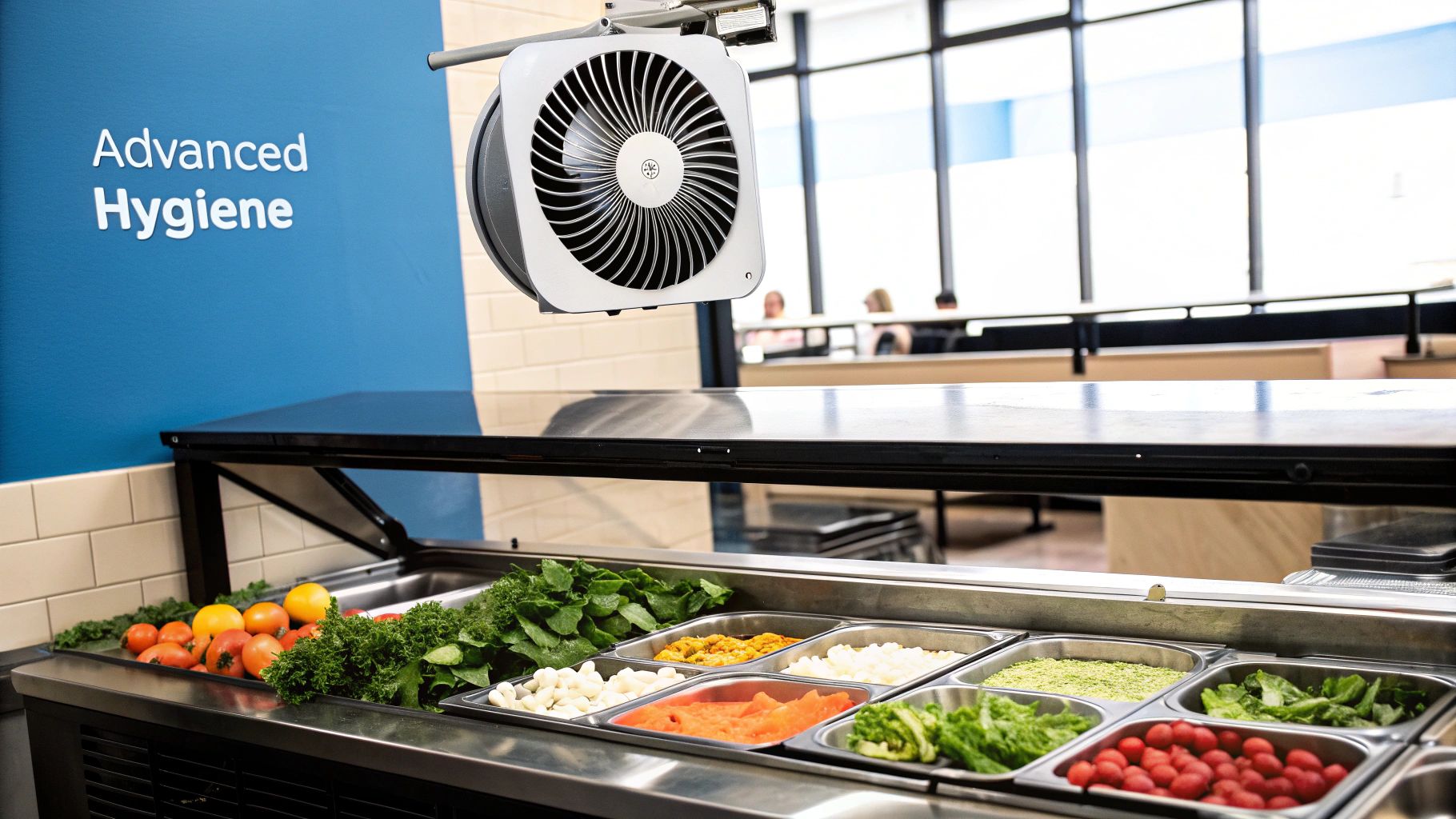
You can master the core principles of food safety, but a truly secure kitchen looks beyond the obvious. It’s about tackling unseen threats, like airborne contaminants from flying insects.
Flies aren't just an annoyance; they're vectors for disease. They land on garbage or animal waste, picking up pathogens like Salmonella and E. coli on their legs, and then transfer them directly to your food. It's a major gap in many food safety plans, especially for outdoor dining or kitchens with open windows.
Creating a Protective Air Barrier
The most effective way to deal with an airborne threat is an air barrier pests can't cross. This is where modern solutions shine.
Modern Lyfe fly fans create a constant, gentle airflow that disrupts an insect's flight path, forming an invisible shield over your food. Unlike zappers or chemical sprays, these fans are quiet, safe, and don't ruin the dining experience. Their soft, reflective blades also disorient flies, adding another layer of deterrence.
Placement is everything.
- For Buffets: Put one fan at each end to create an air current that covers the entire spread.
- On Dining Tables: A single fan in the center is usually enough to protect everyone’s plates.
- In Prep Areas: Placing fans near open prep stations stops pests from contaminating ingredients before you start cooking.
These devices aren't just for backyard barbecues. They're a valuable tool in any setting where food is exposed, from catered events to restaurant patios. They actively prevent contamination from happening in the first place.
Learning how to keep flies away from food is a crucial part of a complete hygiene strategy that many people overlook.
Implementing a Robust Pest Control Program
Beyond flying insects, a comprehensive pest control program is non-negotiable. This isn’t about reacting to a problem—it’s about preventing one. A solid program denies pests the three things they need: food, water, and shelter.
Seal cracks in walls and floors, ensure proper drainage to eliminate standing water, and stick to a strict cleaning schedule to remove any crumbs. Working with a professional pest control service can help you spot vulnerabilities you might miss.
Managing Allergens and Water Purity
Taking hygiene to the next level also means tackling other risks, like allergens and water quality. For someone with a severe allergy, cross-contact is just as dangerous as pathogen cross-contamination.
Follow these best practices for managing allergens:
- Dedicated Equipment: Use separate cutting boards, utensils, and fryers for common allergens like peanuts, shellfish, or gluten.
- Clear Labeling: Ensure every ingredient is clearly labeled and staff knows which dishes contain major allergens.
- Thorough Cleaning: After preparing a dish with a known allergen, sanitize all surfaces and equipment before moving on. Good practices for cleaning kitchen countertops are a great starting point.
Finally, don't forget your water. A compromised water source can contaminate everything from washed produce to ice cubes. Regularly check and maintain water filters and ensure your plumbing is up to code. These advanced steps shift you from reacting to threats to proactively building a safe and resilient kitchen.
Building a Strong Food Safety Culture
You can have the best equipment and the freshest ingredients, but none of it matters if your team isn't bought in. A strong food safety culture is your single best defense against foodborne illness. It's not about rules; it's about turning those rules into reflexive habits.
This goes beyond checklists. It’s about creating an environment where everyone—from a head chef to a teenager at home—understands why these practices are critical. It’s a shared belief that keeping people safe is everyone’s job.
In a professional kitchen, this culture starts at the top. When a manager meticulously washes their hands and always uses a thermometer, it sends a clear message: food safety is the standard.
Fostering Accountability and Training That Sticks
For any food business, building this culture comes down to consistent training and clear accountability. Training can't be a one-time event. It has to be an ongoing conversation that keeps good habits fresh.
Good training is practical. Use real-world scenarios to show how a small slip-up can have huge consequences. Don't just tell staff to "report illnesses"—create a clear, supportive protocol for when an employee must stay home, one that doesn't punish them for putting public health first.
Accountability means everyone feels comfortable speaking up. If a line cook sees a server grab a garnish with their bare hands, they should feel empowered to say something. Peer-to-peer accountability is the sign of a healthy safety culture. For a deeper look at professional standards, our article on food safety restaurant guidelines is a great resource.
Embedding Vigilance in the Home Kitchen
This same mindset works at home. It’s about making good habits a normal part of your family’s routine. Show your kids how to wash their hands properly and explain why you use different cutting boards for raw meat and veggies.
Make food safety part of the conversation around cooking. When you check a chicken's temperature, mention that you're making sure it's cooked through to kill any germs. These small actions turn kitchen tasks into powerful teaching moments.
The need for constant diligence is backed by data. In the United States, failures in practice often lead to significant health burdens. A strong culture of safety is the best tool to prevent these outcomes.
The reality is that foodborne illnesses are still a major problem. In 2019, seven major pathogens caused an estimated 9.9 million foodborne illnesses in the U.S. alone. Those cases led to 53,300 hospitalizations and 931 deaths, a stark reminder of the consequences. You can explore more on the CDC's findings regarding the foodborne illness burden to grasp the full scale of the issue.
Ultimately, preventing foodborne illness comes down to consistent, mindful action. Whether you're running a busy restaurant or making dinner for two, building a culture where safety is a non-negotiable value is the most effective thing you can do.
Answering Your Top Food Safety Questions
Even with the best training, questions come up. Having the right answers ready is key to preventing foodborne illness. Let's tackle some of the most common dilemmas.
Can I Still Eat Food That's Been Left Out for a Few Hours?
It's a classic scenario: you forget to put away the leftovers. While it’s tempting to save the food, it's a big gamble.
The rule is simple: the two-hour rule. Any perishable food—meat, dairy, cooked casseroles—must be in the fridge within two hours. If the room is hot, above 90°F (32°C), that window shrinks to just one hour. After that, bacteria multiply rapidly. The only safe move is to toss it.
Is the "Five-Second Rule" Real?
No. It's a myth. Bacteria don't wait; they can latch onto food the instant it hits a contaminated surface.
If food drops on the floor, let it go. It's not worth the risk.
This isn't just about preventing an upset stomach. The CDC estimates that foodborne illnesses cause 48 million sicknesses and 3,000 deaths in the U.S. annually. Following proven safety rules is the only way to protect your guests, your family, and yourself.
How Can I Tell if My Food Has Gone Bad?
This is the tricky part: the most dangerous bacteria, like Salmonella and Listeria, are invisible. You can't see, smell, or taste them.
Obvious signs like mold or a sour smell are clear red flags, but food can be teeming with harmful pathogens long before it looks or smells off. This is why proper storage times and "use-by" dates are critical. When in doubt, throw it out. It’s a simple mantra that can save you a lot of trouble.
Should I Wash Raw Chicken Before Cooking It?
Absolutely not. Rinsing raw chicken is one of the quickest ways to spread germs around your kitchen.
The water splashes bacteria onto your sink, countertops, and anything else nearby, creating a serious cross-contamination risk. The only effective way to destroy pathogens on raw poultry is to cook it to the proper internal temperature.
What Is the Difference Between Food Poisoning and Foodborne Illness?
People often use these terms interchangeably, which is fine for everyday use. But there's a technical difference.
- Foodborne Illness: This is the broad term for any sickness from contaminated food, whether from bacteria, viruses, or parasites.
- Food Poisoning: This specifically refers to illnesses caused by toxins that bacteria produce in the food itself, like the toxin that causes botulism.
In the end, what you call it doesn't matter as much as how you prevent it. The principles of Clean, Separate, Cook, and Chill are your best defense against all types of food contamination.
Ready to add another layer of defense to your food prep and dining areas? MODERN LYFE offers a simple, effective way to keep flies and other airborne pests from landing on your food. Explore our fly fans and see how easy it is to create a more hygienic space.

